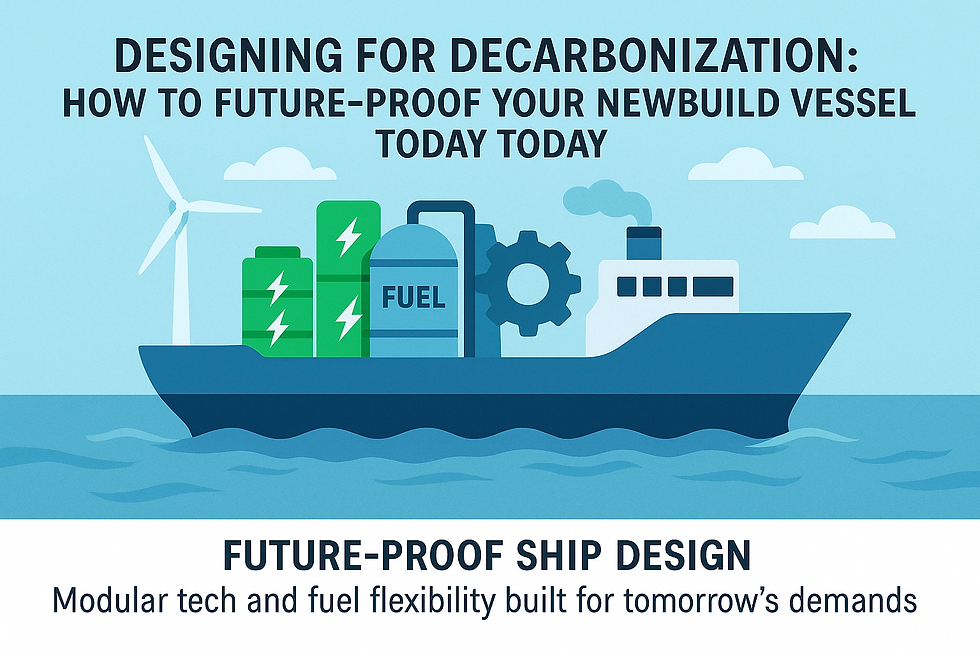Smart Shipbuilding: How to Integrate Innovation into Modern Newbuilds
- Davide Ramponi

- 10. Feb.
- 4 Min. Lesezeit
Aktualisiert: 30. Mai
My name is Davide Ramponi, I am 20 years old and currently training as a shipping agent in Hamburg. In my blog, I take you with me on my journey into the exciting world of shipping. I share my knowledge, my experiences, and my progress on the way to becoming an expert in the field of Sale and Purchase – the trade with ships.

The shipping industry is not just navigating oceans—it’s also navigating a digital transformation. With technological innovations advancing rapidly, shipowners are asking one key question: How can we integrate modern tech into newbuilds to remain competitive, efficient, and compliant?
From autonomous navigation systems to digital twins and data-driven efficiency upgrades, the world of newbuild design is changing fast. These innovations not only help shipowners meet regulatory and environmental standards but also unlock new operational capabilities.
In this post, I’ll guide you through the latest technologies shaping ship design, discuss the costs and long-term benefits, and share real-world examples of how innovation is already transforming the newbuilding sector.
Latest Technologies in Ship Designs: The Future Has Arrived
Modern shipbuilding is moving far beyond steel hulls and diesel engines. Today’s newbuilds are designed with **intelligence, automation, and sustainability in mind**. Here are some of the most promising technologies:
1. Autonomous Navigation Systems
Autonomous ships may sound futuristic, but they’re already here—at least in pilot phases. These systems use sensors, cameras, radar, and AI to control and optimize ship navigation.
✅ Benefits:
Reduced crew workload and operational risks.
Improved safety through real-time hazard detection.
Optimal routing to save fuel and time.
Example: Yara Birkeland, the world’s first fully electric and autonomous container ship, is a leading example of autonomy in practice.
2. Digital Twins: A Virtual Mirror of the Vessel
A digital twin is a real-time digital replica of a ship, continuously updated with sensor data.
✅ Benefits:
Predictive maintenance: Spot mechanical issues before they occur.
Performance optimization: Analyze real-time data to improve efficiency and fuel usage.
Scenario planning: Simulate voyage routes or retrofits before implementation.
Digital twins are especially useful for complex, high-value ships like LNG carriers or cruise ships.
3. Efficiency-Driven Design Innovations
Technology is also helping improve traditional elements of ship design.
🔹 Hull optimization using CFD (computational fluid dynamics) simulations.
🔹 Air lubrication systems to reduce friction and save fuel.
🔹 Smart engine management for dynamic fuel consumption adjustment.
These advancements are helping owners build vessels that are not only regulatory compliant but also more profitable to operate.
Costs and Benefits of Innovation: A Long-Term Investment
Innovation doesn’t come cheap—but the return on investment can be substantial.
1. Upfront Costs: What Shipowners Should Expect
Autonomous systems and AI-driven software require substantial investment in sensors, training, and integration.
Implementing digital twins involves high initial costs in hardware, software licenses, and data infrastructure.
Efficiency improvements such as hull upgrades or hybrid propulsion systems also add to the newbuild’s price tag.
However, the real question isn’t “What does it cost?” but “What does it save?”
2. Long-Term Benefits: Operational and Financial
✅ Reduced Fuel Consumption: Innovations like optimized hulls and real-time routing lead to double-digit savings on fuel.
✅ Lower Maintenance Costs: Predictive maintenance through digital twins helps avoid expensive breakdowns and downtime.
✅ Improved Safety and Compliance: Autonomous features and smart systems ensure regulatory adherence and reduce the chance of accidents.
In many cases, shipowners recoup their investment within a few years—especially when fuel and maintenance savings are factored in.
Case Studies: Innovation in Action
Let’s take a look at real-world examples of how shipowners and shipyards are already implementing cutting-edge technologies.
Case 1: NYK Line’s Digital Twin Pilot
Japan-based NYK Line launched a bulk carrier equipped with a full digital twin system, enabling real-time performance tracking.
✅ Outcome:
Fuel consumption reduced by 8%.
Maintenance intervals extended safely, reducing costs.
Crew received data-driven insights to improve operations.
Case 2: Rolls-Royce & Kongsberg’s Autonomous Ferry Project
In Norway, the world’s first autonomous passenger ferry was tested using systems developed by Rolls-Royce and Kongsberg Maritime.
✅ Outcome:
Navigated safely with zero crew on board.
Docking and route adjustments handled entirely by software.
Regulatory authorities now considering broader implementation.
Case 3: ABB’s Hybrid Electric Propulsion on Cruise Ships
ABB installed hybrid electric propulsion systems on new cruise vessels to reduce carbon footprint and noise pollution in sensitive areas.
✅ Outcome:
Allowed zero-emission port operations.
Enhanced passenger comfort and compliance with environmental regulations.
These examples prove that tech-driven newbuilds are no longer an experiment—they’re the future.
Conclusion: Building the Future Starts Today
As shipping moves toward a more digital and sustainable future, integrating innovation into newbuilds is no longer a luxury—it’s a strategic necessity.
🔹 Technologies like autonomous systems, digital twins, and efficiency upgrades are already delivering measurable value.
🔹 The initial investment pays off through fuel savings, better maintenance, and improved safety.
🔹 Early adopters are gaining a competitive edge—both operationally and reputationally.
For shipowners planning their next newbuild, the question isn’t Should we innovate?—but rather How far ahead can we go?
Have you seen innovation shaping the newbuilding market? What technologies do you believe will define the ships of tomorrow? Let’s discuss in the comments—I look forward to the exchange! 🚢🧠





Kommentare